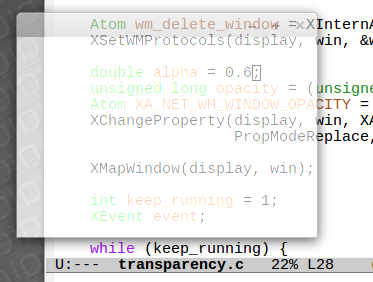I would like to create a semi transparent white window in XLib, but the window is not semi translucent, it remains fully opaque. I use the compton compositor and there are transparent windows in the system, so the problem is in the code:
#include <X11/Xlib.h>
#include <X11/Xutil.h>
#include <stdio.h>
int main(int argc, char* argv[])
{
Display* display = XOpenDisplay(NULL);
XVisualInfo vinfo;
XMatchVisualInfo(display, DefaultScreen(display), 32, TrueColor, &vinfo);
XSetWindowAttributes attr;
attr.colormap = XCreateColormap(display, DefaultRootWindow(display), vinfo.visual, AllocNone);
attr.border_pixel = 0;
attr.background_pixel = 0x80ffffff;
Window win = XCreateWindow(display, DefaultRootWindow(display), 0, 0, 300, 200, 0, vinfo.depth, InputOutput, vinfo.visual, CWColormap | CWBorderPixel | CWBackPixel, &attr);
XSelectInput(display, win, StructureNotifyMask);
GC gc = XCreateGC(display, win, 0, 0);
Atom wm_delete_window = XInternAtom(display, "WM_DELETE_WINDOW", 0);
XSetWMProtocols(display, win, &wm_delete_window, 1);
XMapWindow(display, win);
int keep_running = 1;
XEvent event;
while (keep_running) {
XNextEvent(display, &event);
switch(event.type) {
case ClientMessage:
if (event.xclient.message_type == XInternAtom(display, "WM_PROTOCOLS", 1) && (Atom)event.xclient.data.l[0] == XInternAtom(display, "WM_DELETE_WINDOW", 1))
keep_running = 0;
break;
default:
break;
}
}
XDestroyWindow(display, win);
XCloseDisplay(display);
return 0;
}


